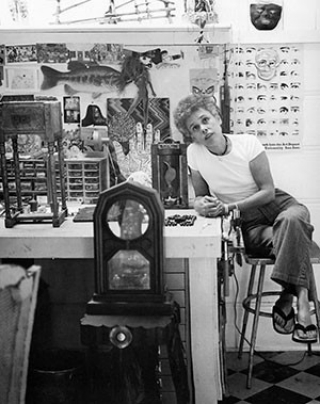Born 1926, Los Angeles, California
Profiting from formative encounters with craft, design, and the work of Joseph Cornell in the early 1960s, Betye Saar shared an affinity with American jazz composer Sun Ra and others for the liberation afforded by mystical cosmologies. But the turmoil of the civil rights era—the 1965 riots devastating Watts, where Saar as a child had witnessed Simon Rodia create his monumental towers—galvanized a growing political consciousness and grounded her ecumenical aesthetics.
Saar first experienced African art on a visit to Chicago’s Field Museum of Natural History with fellow artist David Hammons in 1970. This precipitated a series of “mojos,” syncretic assemblages emulating African amulets, as well as freestanding altarlike structures in which, as Jane Carpenter has argued, Saar “felt she could harness the pull of ancestral past and its subconscious memory.”[1] Her subsequent cross-cultural assemblages typically commingle mundane trinkets, spiritual emblems from diverse cultures, and talismanic forms from African and New World ancestral traditions. Indigo Mercy, an iconic work, consists of a wooden clock atop a rustically hewn palm frond table painted deep blue. Apothecary bottles, mystical diagrams, and a doll-turned-fetish occupy the vacant areas of the clock, and a beaded necklace, burnt candles, and astrological and Christian symbols adorn the altar.
Saar, who prefers the vitality of worn objects to the sterility of new, initially culled discards from local flea markets and family keepsakes. In the early 1970s she was the first among a group of Los Angeles artists, including Noah Purifoy and John Outterbridge, to incorporate so-called black collectibles into her work, appropriating commercially produced racial caricatures to interrogate stereotypes of race and gender. In Sambo’s Banjo, the banjo case is wedged open by a slice of watermelon to reveal two depositories in the long neck: one containing a black skeleton and a photograph of a lynching, and another with a toy rifle propped against a drawing of the eponymous player. With mordant wit Saar hangs a child’s marionette of the docile buffoon directly below the depositories: for he is but another face of slavery.
Lauren Schell Dickens
[1] Carpenter 2003, 28.
Carpenter, Jane H., with Betye Saar. Betye Saar. San Francisco: Pomegranate, 2003.
Betye Saar: Extending the Frozen Moment. Ann Arbor: University of Michigan Museum of Art, with the University of California Press, Berkeley, 2005.
